The investigation of ESPT for 2,8-diphenyl-3,7-dihydroxy-4H,6H-pyrano[3,2-g]-chromene-4,6-dione: single or double?
Abstract
The dynamic overall perspective of an excited-state proton transfer (ESPT) process for 2,8-diphenyl-3,7-dihydroxy-4H,6H-pyrano[3,2-g]-chromene-4,6-dione (D3HF) is investigated based on a time-dependent density functional theory (TDDFT) method. The intramolecular hydrogen bonds of D3HF (O1–H2⋯O3 and O4–H5⋯O6) are demonstrated to be strengthened in the first excited state, which provides the possibility for an ESPT process. Frontier molecular orbitals (MOs) indicate the nature of the intramolecular charge transfer. The corresponding Mulliken’s charge distribution and natural bond orbital (NBO) analysis as well as the Wiberg bond order can be used as reasonable evidence that the ESPT process occurs due to charge transfer. The reduced dimensionality potential energy surfaces (PESs) of the S0 and S1 states have been constructed to explain whether a single or double proton transfer process occurs. The heights of potential barriers among the local minima on the S1 PES indicate that an excited-state single proton transfer mechanism occurs for D3HF. In turn, through the process of radiative transition, the single proton-transfer SPT-D3HF structure returns to the ground state with 582.5 nm fluorescence. Eventually, the almost negligible low barrier facilitates a reversed GSIPT process.
![Graphical abstract: The investigation of ESPT for 2,8-diphenyl-3,7-dihydroxy-4H,6H-pyrano[3,2-g]-chromene-4,6-dione: single or double?](/en/Image/Get?imageInfo.ImageType=GA&imageInfo.ImageIdentifier.ManuscriptID=C5RA14601A&imageInfo.ImageIdentifier.Year=2015)

 Please wait while we load your content...
Please wait while we load your content...